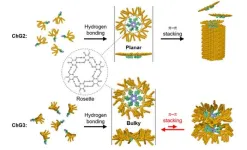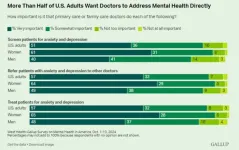(Press-News.org) “For the first time, we have succeeded in taking a zoomed-in image of a dying star in a galaxy outside our own Milky Way,” says Keiichi Ohnaka, an astrophysicist from Universidad Andrés Bello in Chile. Located a staggering 160 000 light-years from us, the star WOH G64 was imaged thanks to the impressive sharpness offered by the European Southern Observatory’s Very Large Telescope Interferometer (ESO’s VLTI). The new observations reveal a star puffing out gas and dust, in the last stages before it becomes a supernova.
“We discovered an egg-shaped cocoon closely surrounding the star,” says Ohnaka, the lead author of a study reporting the observations published today in Astronomy & Astrophysics. “We are excited because this may be related to the drastic ejection of material from the dying star before a supernova explosion.”
While astronomers have taken about two dozen zoomed-in images of stars in our galaxy, unveiling their properties, countless other stars dwell within other galaxies, so far away that observing even one of them in detail has been extremely challenging. Up until now.
The newly imaged star, WOH G64, lies within the Large Magellanic Cloud, one of the small galaxies that orbits the Milky Way. Astronomers have known about this star for decades and have appropriately dubbed it the ‘behemoth star’. With a size roughly 2000 times that of our Sun, WOH G64 is classified as a red supergiant.
Ohnaka’s team had long been interested in this behemoth star. Back in 2005 and 2007, they used ESO’s VLTI in Chile’s Atacama Desert to learn more about the star’s features, and carried on studying it in the years since. But an actual image of the star had remained elusive.
For the desired picture, the team had to wait for the development of one of the VLTI’s second-generation instruments, GRAVITY. After comparing their new results with other previous observations of WOH G64, they were surprised to find that the star had become dimmer over the past decade.
“We have found that the star has been experiencing a significant change in the last 10 years, providing us with a rare opportunity to witness a star’s life in real time,” says Gerd Weigelt, an astronomy professor at the Max Planck Institute for Radio Astronomy in Bonn, Germany and a co-author of the study. In their final life stages, red supergiants like WOH G64 shed their outer layers of gas and dust in a process that can last thousands of years. "This star is one of the most extreme of its kind, and any drastic change may bring it closer to an explosive end," adds co-author Jacco van Loon, Keele Observatory Director at Keele University, UK, who has been observing WOH G64 since the 1990s.
The team thinks that these shed materials may also be responsible for the dimming and for the unexpected shape of the dust cocoon around the star. The new image shows that the cocoon is stretched-out, which surprised scientists, who expected a different shape based on previous observations and computer models. The team believes that the cocoon’s egg-like shape could be explained by either the star’s shedding or by the influence of a yet-undiscovered companion star.
As the star becomes fainter, taking other close-up pictures of it is becoming increasingly difficult, even for the VLTI. Nonetheless, planned updates to the telescope’s instrumentation, such as the future GRAVITY+, promise to change this soon. “Similar follow-up observations with ESO instruments will be important for understanding what is going on in the star,” concludes Ohnaka.
More information
ESO’s Very Large Telescope Interferometer is able to combine light collected by the telescopes of ESO’s Very Large Telescope (VLT), either the four 8-metre Unit Telescopes or the four smaller Auxiliary Telescopes, creating highly detailed pictures of the cosmos. Effectively, this makes the VLTI a “virtual” telescope with a resolution equivalent to the maximum distance between the individual telescopes. This process is highly complex and needs instruments especially dedicated to this task. Back in 2005 and 2007 Ohnaka’s team had access to the first generation of these instruments: MIDI. While impressive for its time, those observations with MIDI only combined the light from two telescopes. Now, researchers have access to GRAVITY, a second-generation instrument able to capture the light of four telescopes. Its improved sensitivity and resolution made the image of WOH G64 possible. But there is more to come. GRAVITY+ is a planned upgrade of GRAVITY which will be able to take advantage of different technological updates performed at the VLTI and VLT. With these, the VLTI will be able to see objects fainter and farther than ever before.
This research was presented in a paper to appear in Astronomy and Astrophysics (https://www.aanda.org/10.1051/0004-6361/202451820).
The team is composed of: K. Ohnaka (Instituto de Astrofísica, Departamento de Física y Astronomía, Facultad de Ciencias Exactas, Universidad Andrés Bello), K.-H. Hofmann (Max Planck Institute for Radio Astronomy, Bonn, Germany [MPIfR]), G. Weigelt (MPIfR), J. Th. van Loon (Lennard-Jones Laboratories, Keele University, United Kingdom), D. Schertl (MPIfR), S. R. Goldman (Space Telescope Science Institute, Baltimore, USA).
The European Southern Observatory (ESO) enables scientists worldwide to discover the secrets of the Universe for the benefit of all. We design, build and operate world-class observatories on the ground — which astronomers use to tackle exciting questions and spread the fascination of astronomy — and promote international collaboration for astronomy. Established as an intergovernmental organisation in 1962, today ESO is supported by 16 Member States (Austria, Belgium, Czechia, Denmark, France, Finland, Germany, Ireland, Italy, the Netherlands, Poland, Portugal, Spain, Sweden, Switzerland and the United Kingdom), along with the host state of Chile and with Australia as a Strategic Partner. ESO’s headquarters and its visitor centre and planetarium, the ESO Supernova, are located close to Munich in Germany, while the Chilean Atacama Desert, a marvellous place with unique conditions to observe the sky, hosts our telescopes. ESO operates three observing sites: La Silla, Paranal and Chajnantor. At Paranal, ESO operates the Very Large Telescope and its Very Large Telescope Interferometer, as well as survey telescopes such as VISTA. Also at Paranal ESO will host and operate the Cherenkov Telescope Array South, the world’s largest and most sensitive gamma-ray observatory. Together with international partners, ESO operates ALMA on Chajnantor, a facility that observes the skies in the millimetre and submillimetre range. At Cerro Armazones, near Paranal, we are building “the world’s biggest eye on the sky” — ESO’s Extremely Large Telescope. From our offices in Santiago, Chile we support our operations in the country and engage with Chilean partners and society.
Links
Research paper
Photos of the VLT and the VLTI
For journalists: subscribe to receive our releases under embargo in your language
For scientists: got a story? Pitch your research
Contacts
Keiichi Ohnaka
Universidad Andrés Bello
Santiago, Chile
Tel: +56-9522 39623
Email: k1.ohnaka@gmail.com
Gerd Weigelt
Max Planck Institute for Radio Astronomy
Bonn, Germany
Tel: +49 228 525 243
Email: gweigelt@mpifr-bonn.mpg.de
Jacco van Loon
Keele University
Keele, UK
Tel: +44 1782 733331
Email: j.t.van.loon@keele.ac.uk
Bárbara Ferreira
ESO Media Manager
Garching bei München, Germany
Tel: +49 89 3200 6670
Cell: +49 151 241 664 00
Email: press@eso.org
END
Astronomers take the first close-up picture of a star outside our galaxy
2024-11-21
ELSE PRESS RELEASES FROM THIS DATE:
Here’s something Americans agree on: Sports build character
2024-11-21
COLUMBUS, Ohio – In a polarized nation, there is one thing that nearly all Americans agree on, according to a recent study: Sports are good for us.
Researchers from The Ohio State University and Ithaca College found that more than 9 out of 10 Americans agreed that sports build character and improved one’s health, while 84% agreed playing sports makes one popular in school and 85% said it makes one more well-known in the community.
According to 67% of those surveyed, playing sports even leads to better grades in school.
While these beliefs may seem harmless, ...
Engineering nature’s blueprint: Dendron-based assemblies for chlorophyll’s materials
2024-11-21
Researchers often look to photosynthesis—a process that turns sunlight into chemical energy in plants and bacteria—as a model for innovation. Photosynthesis is in turn linked to chlorophyll pigments, tiny green molecules that play a key role in harvesting light. Naturally, these chlorophyll molecules are organized into precise structures to optimize light absorption in plants and bacteria, and efficiently capture sunlight for energy. Inspired by this natural structure, scientists have explored ways to synthetically assemble chlorophyll-based ...
Study reveals how cell types shape human brain networks
2024-11-21
Rutgers researchers at the Brain Health Institute (BHI) and Center for Advanced Human Brain Imaging Research (CAHBIR) have uncovered how different types of brain cells work together to form large-scale functional networks in the human brain – interconnected systems that support everything from sensory processing to complex decision-making – paving the way for new insights into brain health and disease.
By pinpointing these cellular foundations, the study, published in Nature Neuroscience, offers a deeper understanding of the cellular foundations of cognition and mental health.
The brain’s functional properties arise from the varied ...
New genetic explanation for heart condition revealed
2024-11-21
A potentially life-changing heart condition, dilated cardiomyopathy, can be caused by the cumulative influence of hundreds or thousands of genes and not just by a single “aberrant” genetic variant, as was previously thought, finds a new study led by researchers at UCL (University College London), Imperial College London and the MRC Laboratory of Medical Sciences.
Dilated cardiomyopathy (DCM) is a condition in which the heart becomes progressively enlarged and weakened, reducing its ability to pump blood efficiently. It is estimated to affect up to 260,000 people in the UK (one in every 250 individuals) and is the leading cause of heart transplantation.
Previously, ...
Poor mental health linked to browsing negative content online
2024-11-21
People with poorer mental health are more prone to browsing negative content online, which further exacerbates their symptoms, finds a study led by UCL researchers.
The relationship between mental health and web-browsing is causal and bi-directional, according to the Wellcome-funded study published in Nature Human Behaviour.
The researchers have developed a plug-in tool* that adds ‘content labels’ to webpages—similar to nutrition labels on food—designed to help users make healthier and more informed decisions about the ...
People with migraine at high risk of depression during pandemic
2024-11-21
Toronto, ON – A recent longitudinal study from the University of Toronto reveals the mental health consequences of the COVID-19 pandemic on older adults living with migraine.
Using a sample of more than 2,000 older adults with migraine from the Canadian Longitudinal Study on Aging, researchers examined changes in depression status among this population during the pandemic. More than 1 in 7 older adults with migraine experienced depression for the first time during the COVID-19 pandemic, while approximately 1 in 2 with a previous history of depression experienced a recurrence during this period.
“People ...
Climate-driven hazards increases risk for millions of coastal residents, study finds
2024-11-21
A new study published in Nature Climate Change estimates that a 1-meter sea level rise by 2100 would affect over 14 million people and $1 trillion worth of property along the Southeast Atlantic coast, from Norfolk, Virginia, to Miami, Florida.
The study assesses the cumulative impact of multiple climate-driven coastal hazards, including sea level rise, flooding, beach erosion, sinking land, and rising groundwater, all of which are expected to worsen significantly by the end of the 21st century.
The scale of these interconnected ...
Females sleep less, awaken more frequently than males
2024-11-21
Females sleep less, wake up more often and get less restorative sleep than males, according to a new animal study by CU Boulder researchers.
The findings, published in the journal Scientific Reports, shed new light on what may underlie sleep differences in men and women and could have broad implications for biomedical research, which for decades has focused primarily on males.
“In humans, men and women exhibit distinct sleep patterns, often attributed to lifestyle factors and caregiving roles,” said senior author Rachel Rowe, assistant professor of integrative physiology. “Our results suggest that biological ...
Most Americans want primary care providers to address mental health
2024-11-21
WASHINGTON, D.C. — Nov. 21, 2024 — A majority of Americans (70%) say they would prefer to be asked about both their physical and mental health during medical appointments with their primary care providers (PCPs). The finding from the new West Health-Gallup Survey on Mental Health in America comes as more than one in five U.S. adults, or 59.3 million people, were living with a mental illness in 2022, and little more than half of them (50.6%) received treatment within the prior year.
According to the survey, majorities of men (65%) and women (76%) are eager to discuss both their mental and physical health with their primary ...
Millions of Americans hurt by others’ drinking, drug use: study
2024-11-21
by Amy Norton
PISCATAWAY, NJ – The risks of alcohol and other drug consumption to the user are well known, but many Americans--nearly 160 million--say they’ve been harmed by someone else’s substance use, according to a new study in the Journal of Studies on Alcohol and Drugs.
In a national survey of U.S. adults, researchers found that 34% said they’d ever suffered “secondhand harm” from someone else’s alcohol use--ranging from marriage and family problems to financial fall-out to being assaulted or injured in a drunk-driving accident. Meanwhile, 14% said they’d been harmed ...




